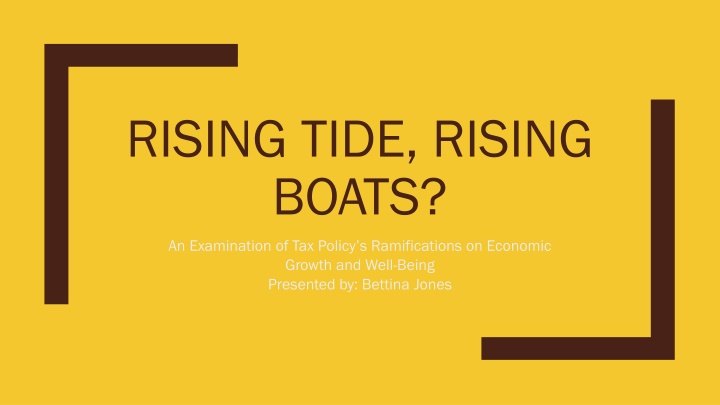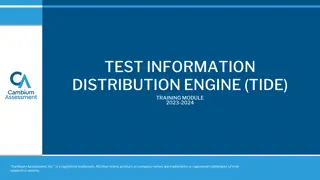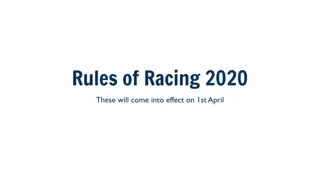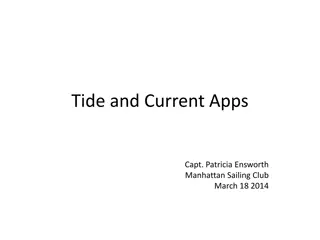RISING TIDE, RISING BOATS?
An examination of the impact of tax policy on economic growth and well-being, exploring the relationship between taxes, growth, and societal welfare. The study delves into the effects of tax cuts, different types of taxes, and the overall equilibrium between growth and welfare. It also reviews literature on the relationship between inequality and growth and presents policy recommendations based on research findings.
Download Presentation

Please find below an Image/Link to download the presentation.
The content on the website is provided AS IS for your information and personal use only. It may not be sold, licensed, or shared on other websites without obtaining consent from the author.If you encounter any issues during the download, it is possible that the publisher has removed the file from their server.
You are allowed to download the files provided on this website for personal or commercial use, subject to the condition that they are used lawfully. All files are the property of their respective owners.
The content on the website is provided AS IS for your information and personal use only. It may not be sold, licensed, or shared on other websites without obtaining consent from the author.
E N D
Presentation Transcript
RISING TIDE, RISING BOATS? An Examination of Tax Policy s Ramifications on Economic Growth and Well-Being Presented by: Bettina Jones
Preview Introduction to the topic Literature review Methodology of the research Problem analysis Policy recommendations Conclusion
Introduction to the Problem Hot debate: what is the overall effect of tax increases/decreases on society? In the U.S., this is usually a partisan issue While free markets are economically efficient, they also experience market failure market failure. What is better for the society overall? Of course, we need both growth and welfare, but what is the equilibrium between the two?
Literature Review Central question of the literature: does growth lead to equality or equality lead to growth? (Which came first, the chicken or the egg?) Many researchers have found that there is a negative relationship negative relationship between taxes and growth. Why? Because taxes increase cost of activities and decrease willingness to risk. is a
Literature Review Different types of taxes can have different economic/social effects Progressive taxes (economically bad, socially good) Regressive taxes (economically good, socially bad) Flat taxes (economically good, socially bad) Basic problem in the literature: Trickle-down economics vs. income equality-first economics = Multiplier effects vs. spend-to-save ratio
Methodology 3 research papers are examined, each arguing different sides of the issue. Both theoretical accuracy and results of the regressions are considered. From the failings/successes of all three papers, 3 main policy recommendations are drawn.
ANALYSIS OF THE PROBLEM Part 1: In Support of Tax Cuts for Economic Growth The Impact of Tax Cuts on Economic Growth: Evidence from the Canadian Provinces. Ferede and Dahlby, 2012.
Ferede and Dahlby, 2012 General results: Higher corporate income tax rate, lower GDP per capita growth rate (-0.125 at the 95% confidence level) These figures were mainly due to the decreased likelihood of investing , which has sense to it. We can only draw conclusions about corporate income taxes sales tax and personal income tax were positive/insignificant.
ANALYSIS OF THE PROBLEM Part 2a: In Support of Income Equality as an Economic Growth Tool Do Rising Top Incomes Lift All Boats? (Andrews, Jencks, and Leigh, 2011).
Andrews, Jencks, and Leigh (2011) Study of 12 developed nations between 1905 and 2000 After 1960, 1% increase in top decile s income share is associated with an 0.12% rise in GDP growth during the following year. Mirror image of Kuznets Curve But, it was also, of course, associated with loss to lower 90% Their boat did not reach a break-even point until 13 years later
ANALYSIS OF THE PROBLEM Part 2b: In Support of Income Equality as an Economic Growth Tool New Data Illustrate the Failure of the Trickle-Down Experiment. (Duke, 2015)
ANALYSIS OF THE PROBLEM Part 3: In Support of Tax Cuts to Boost Growth Marginal Tax Rates and U.S. Growth: Flaws in the 2012 CRS Study (Taylor and Taylor, 2014)
Taylor and Taylor (2014) Before the 2012 U.S. Presidential Election (Incumbent Obama vs. Romney), the Congressional Research Service (CRS) released a paper The paper (Hungerford, 2012) claimed no relationship between marginal tax rates and economic growth This was viewed as politically motivated (supporting Obama and refuting Romney) Taylor and Taylor redid the study using the same data, but making some changes
Taylor and Taylor (2014) They used lags to determine years-long after-effects They used dummy variables to control for various aspects (international/local events, growth rate of monetary base and labor force, etc). The F-Statistic was significant at the 1% confidence level. In Hungerford s study, the F-Statistic was not significant at all, which led him to say there was no relationship.
Policy Recommendations and Conclusions 1. Researchers should be wary of eyeballing bias many control factors as possible into consideration. Time lags should also be put in place to allow time for policy changes to take full effect. 2. Researchers should break down taxes into their types (income, corporate income, sales, property) and also ensure that it is marginal tax rate, not average tax rate, that they consider. 3. Policymakers should be open to accepting the positive sides and negative sides of both arguments. Lowering corporate income taxes does seem to cause economic growth, but economic growth is not necessarily the only measure of a society s well-being. Policies should be more well-rounded. eyeballing bias and take as























